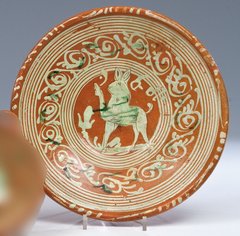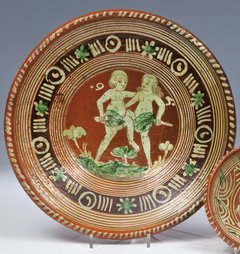 |
| Mudlarking Find: Werra Slipware 1550-1650 |
 |
| Werra Slipware with Rabbit 1607 (Dr Fischer) |
Red bodied earthenware was decorated with a distinctive pale greenish yellowy slip - a thin clay mixture. The decoration tends to follow a standard format divided into zones.
Dashes and lines were quickly struck around the rim of the plate. The potter then expertly looped thin bands of slip spiraling inwards. A wide band of swirls and squiggles forms a boarder followed by another set of bands which frame a central motif. Rather random bright green splashes of copper oxide provide highlights in the centre and surrounding areas.
 |
| Werra Slipware Plate with Pig/Boar 1615 (Museum Rotterdam) |
Animals or figures usually filled the centre. I love these confident, naive, bold, quirky pictures. I can't help think of our wonderful Grayson Perry (whose current Reith lectures on art are not be missed, link here.) when I look at these masterly drawings on pottery.
 |
| Werra Angel 1613 (Museum Rotterdam) |
 |
| Detail of Werra Slipware Horse (Museum Rotterdam) |
 |
| Werra Slipware Nobel Man on Horse back 1621 (Museum Rotterdam) |
 |
| Werra Ware with Dove 1585-1625 (Museum Rotterdam) |
 |
| Mudlarking Find: An angel? wing Werra Slipware 1550-1650. |
 |
| Werra Ware 1615 |
 |
| Mudlarking finds: Werra Ware 1550-1650 |
 |
| Werra Slipware with Adam and Eve 1595 (Dr Fischer) |
 |
| Mudlarking Finds: Werra Slipware 1550-1650 |
 |
| Mudlarking Find - Werra? slipware |
And finally a couple of Grayson Perry pots
.



wow, I always love visiting your blog and learning about mudlarking! this is quite a cool find and love the look of this slipware with green - how unusual, but gorgeous
ReplyDeleteafter seeing your post I think I have a few small pieces of similar composition. Thanks for the updated history lesson! You are a wealth of information!!
ReplyDeleteTim
foreshorefinds.blogspot.com
Hi Julia,
ReplyDeleteWe are very interested to find your blog site with your lovely images and writing. Lizzy Hobbs and I are London artists working on participatory art projects with film and events. You can see our work at www.tracyandhobbs.com
We are developing a project around Mudlarking and would love to talk to you about the work you do. You can contact us through our website if you would be interested.
Many Thanks
Emily
Hi Julia,
ReplyDeleteGreat blog!
I am working on a mid-18th century English fortification site over here on Mid-Coast, Maine, US. An early site for the States. It is fun to compare my ceramics with your finds.
Thank you for your work.
Paul